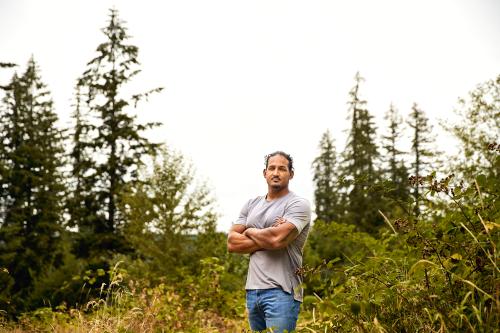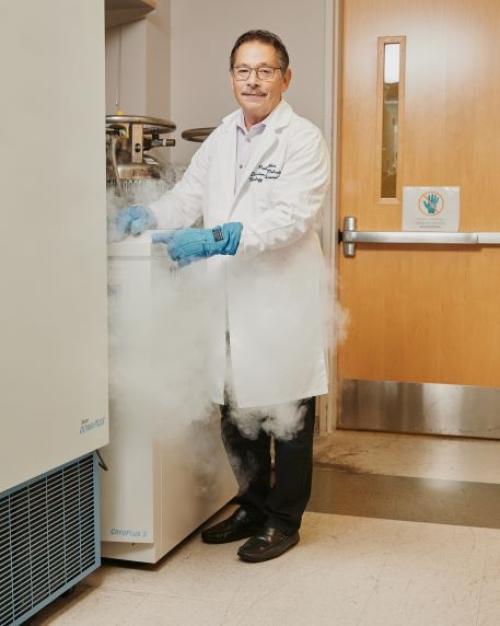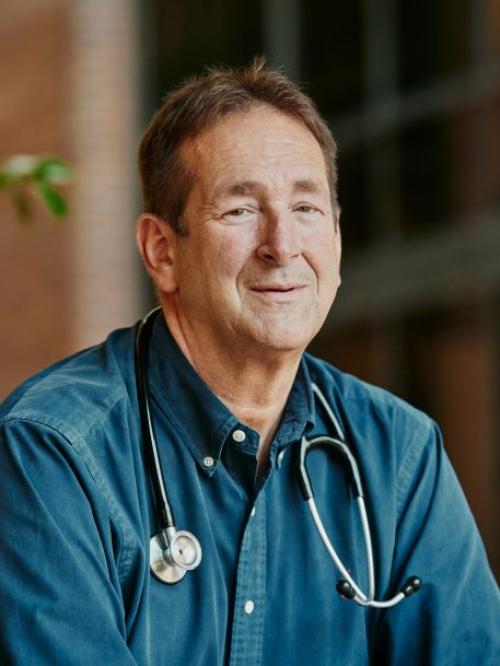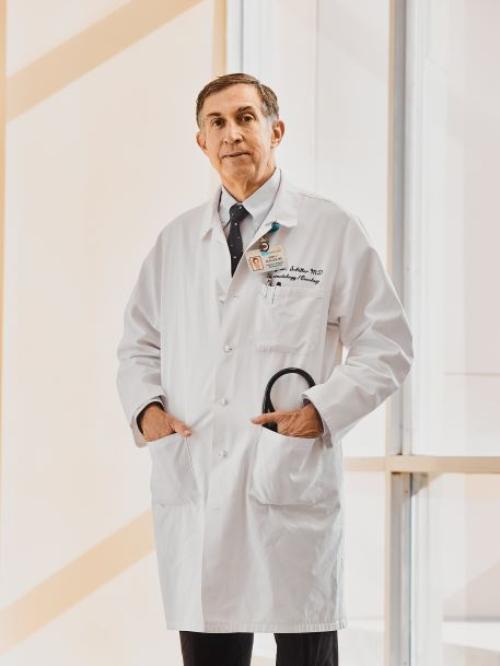
Solving Sickle Cell
If you’d met Evie Junior three years ago, you never would have guessed that his own blood was gradually killing him. At 27 years old, he was tall and muscular, capable of bench-pressing 300 pounds. He pulled long hours as an emergency medical technician, hoisting patients into an ambulance with ease. For most of his life, however, an insidious ailment had been sapping his strength and sending him into paroxysms of pain.
Junior was struggling with sickle cell disease, an inherited disorder marked by defective hemoglobin — the protein in red blood cells that carries oxygen throughout the body. Cells with sickle hemoglobin are stiff, sticky and crescent-shaped. They often clump together, blocking small blood vessels. These snags cause agonizing episodes known as pain crises, centered on the limbs, back or chest. The reduction of blood flow can damage bones, skin and vital organs. Because sickle cells live for only days, compared to months for normal red blood cells, people with the disorder are prone to anemia, with symptoms including fatigue, dizziness and shortness of breath. They’re also vulnerable to stroke, vision loss, lung troubles and infections.
These miseries arise from a defect in a single gene — a mutation most common in people of African ancestry, though it’s also found among several other ethnic groups. People who inherit the glitch from one parent usually have no symptoms. People with copies from both parents may start out with mild illness, but their suffering typically worsens with age. Among the 100,000 patients with sickle cell disease in the United States, median life expectancy is in the 40s.
Growing up in the Bronx, New York, Junior — who is Black and Puerto Rican — faced challenges beyond the poverty endemic to his tough neighborhood. When he was a toddler, his mother would sometimes find him curled on the floor crying, unable to walk. At 3 years old, he had his spleen removed; at 16, his gallbladder. In high school, he was a fierce competitor on the basketball court and the gridiron, but he was dropped from the football team when a pain crisis made him miss tryouts. Though he was smart and intellectually curious, college was out of the question. “I couldn’t enroll in a class and then go to the hospital for three days,” he explains.
Junior did his best to stay well — eating right, exercising devoutly — and took on physically demanding jobs despite his illness. After graduating high school, he worked as a personal trainer, then moved to Portland, Oregon, where he became an EMT. But the pain crises began striking more frequently, often sending him to the emergency room. He was hospitalized with pericarditis, an inflammation of the thin, saclike tissue surrounding the heart. He developed patches of dying bone tissue in both legs.
Aside from painkillers, few effective treatments are available for sickle cell disease. Four medications have been approved by the Food and Drug Administration (FDA); although they can ease symptoms for some patients, they can also cause troublesome side effects. A bone-marrow transplant from a sibling can eliminate the disorder, but fewer than 20% of patients have a brother or sister who is an eligible match.
Junior tried two of the medications. The first made him tired and breathless, and the second did nothing whatsoever. The others, at thousands of dollars per month, were financially out of reach. His doctor referred him to a hematologist, who suggested he look into a transplant. Junior’s sister agreed to be tested as a possible donor, but she proved to be incompatible. His only remaining option, the specialist said, was an experimental treatment: stem-cell gene therapy, in which his blood stem cells would be genetically modified to produce non-sickling hemoglobin. But no one could be sure that it would help him, she warned, and there was a chance that it would do him harm.
“I told her I was willing to risk it all,” Junior recalls. “Nothing could be worse than just sitting here and dying slowly.” He asked where the nearest clinical trial was being conducted. That’s how he found himself at UCLA.
THE TRIAL THAT JUNIOR JOINED IN JULY 2019 IS ONE OF SEVERAL SICKE CELL STUDIES currently ongoing or planned at the Eli and Edythe Broad Center of Regenerative Medicine and Stem Cell Research at UCLA. It’s also part of a larger group of studies, at academic centers and biotech companies in several countries, whose preliminary findings offer hope that a cure for sickle cell disease is close.

In the past five years or so, dozens of participants in these trials have found lasting reprieves from their pain and other complications from a single infusion of genetically modified stem cells. There have been setbacks, too, and the durability of the positive results remains to be seen. Still, the mood in the field is judiciously upbeat. “It’s too soon to use the ‘c’ word, to say there’s a cure,” says Donald B. Kohn, MD, Distinguished Professor of Microbiology, Immunology & Molecular Genetics, and professor of pediatric hematology-oncology. “But things are looking very promising.”
What makes the recent breakthroughs all the more remarkable is that research on gene therapy for sickle cell began far later than for many other conditions. In part, this reflects the perennial shortage of funding for maladies that mostly affect people of color in low-income parts of the world. But the slow start also stems from the nature of this disease.
“It’s a hard target,” observes Dr. Kohn, who serves as medical director of the UCLA Human Gene and Cell Therapy Program — and who’d spent two decades devising gene therapies for other deadly ailments by the time he tackled sickle cell. To understand what it took for scientists to turn the tables on this formidable adversary, it helps to start with his story.
DR. KOHN DISCOVERED HIS CALLING DURING HIS FIRST YEAR OF MEDICAL SCHOOL at the University of Wisconsin, when he heard a lecture by Richard Hong, MD, who’d recently performed the first bone-marrow transplants on children with severe combined immunodeficiency (SCID)‚ or “bubble baby syndrome” — a genetic disorder that left them without a functioning immune system. He went on to do his pediatric residency with Dr. Hong, followed by a fellowship at the National Institutes of Health (NIH) under immunologist R. Michael Blaese, MD, who was helping to develop the earliest gene therapy for SCID.
In 1987, Dr. Kohn became an attending physician in the bone-marrow transplantation program at Children’s Hospital Los Angeles. But in his own research, he would focus on gene therapy as an alternative to such transplants for a wide range of ills. Eventually, he became director not only of bone-marrow transplantation, but also of the hospital’s research-immunology and gene-therapy programs, a sign of both his multidisciplinary expertise and the interconnectedness of the three fields.
From early on, Dr. Kohn recognized that bone-marrow transplants — though they can be life-saving for patients with disorders ranging from immunodeficiencies to blood cancers to hemoglobinopathies — have serious drawbacks. The need to find a compatible donor is just one of them. “I’ve probably done 500 of these procedures, and every one of them is scary,” he says. “You’re taking someone to the edge of a cliff, handing them a parachute and hoping it opens before they hit the ground.”
Before the transplant, chemotherapy is used to suppress the immune system and make room in the patient’s own marrow for the transplant. This is a harrowing process that is sometimes fatal. If all goes well, the patient then receives blood stem cells from the donor; these go on to make new marrow, which produces healthy blood cells. Further dangers loom, however. The patient must take immunosuppressant drugs to prevent rejection, raising the risk of infections and malignancies. The transplanted marrow can attack the patient’s tissues, a reaction known as graft-versus-host disease. Or the patient’s refurbished immune system can malfunction, failing to guard against microbial intruders.
Gene therapy strives to avoid these downsides by using cells harvested from the patient’s own body. These are genetically modified to combat a specific disease, then returned to the patient in a so-called “autologous” transplant. The process was first completed successfully in 1990, in a 4-year-old girl with a form of immunodeficiency known as ADA-SCID. An NIH team made the breakthrough, using a tool that Dr. Kohn had worked on during his fellowship: a retroviral vector.
A vector is the technical term for a carrier that delivers new genetic information into target cells. Viruses are well-suited for this purpose, because they reproduce by reprogramming a cell’s DNA. And retroviruses, which carry their genetic material in the form of RNA, have an added advantage: Unlike some of their viral kin, they can integrate their genes into a host’s chromosomal DNA, ensuring that the changes are preserved as cells reproduce.
The mutation that causes ADA-SCID occurs in the ADA gene, which enables the body to produce an enzyme crucial to the growth of T- and B-lymphocytes — white blood cells that function as the foot soldiers of the immune system. Without this enzyme, stem cells that give rise to the lymphocytes die before they mature. To fix the problem, the researchers made a vector based on a mouse leukemia retrovirus. After removing the virus’s disease-causing RNA, they used genetic engineering to load it with a corrected version of the ADA gene.
Next, the NIH team collected T-lymphocytes from the girl, who was taking medication that enabled them to grow to maturity. After culturing large numbers in the lab, the team infected the cells with the modified retrovirus. Finally, the researchers infused the infected T-cells — now carrying the corrected gene — back into the patient.
The girl’s immunodeficiency improved markedly, and she was able to enroll in school and live a normal life. But her lymphocyte counts fluctuated, and she needed continuing treatments to remain healthy. Among the lessons that researchers learned from this experiment was that gene therapy for blood disorders had to be aimed at stem cells to have maximum effect. This is because blood stem cells can self-renew and produce all kinds of blood and immune cells, which means that genetically corrected blood stem cells should be able to persist and produce healthy cells throughout a patient’s life.
While the NIH researchers were delivering the first gene therapy for ADA-SCID, Dr. Kohn and his lab at Children’s Hospital branched out to other diseases — mainly HIV and blood cancers — while developing new methods for culturing stem cells and creating viral vectors. Like many other gene-therapy researchers, he was eager to try such approaches on sickle cell disease, as well. But there were two major obstacles: First, judging by the results of bone-marrow transplants, controlling sickle cell symptoms would require correcting 20-to-50% of a patient’s blood stem cells, versus just 5% in SCID. “We needed to get better at transferring genes into the stem cells,” Dr. Kohn explains.
The second hurdle to tackling sickle cell disease was that the mutation that caused it was dauntingly complex. Unlike the defect in the ADA gene, which prevented cells from producing a necessary enzyme, the sickle cell mutation instructed cells to make an abnormal protein. “We had to find some way to counter it,” says Dr. Kohn. “The technology wasn’t there yet.”
BY THE EARLY 2000S, GENE-THERAPY TECHNIQUES FOR BLOOD DISORDERS HAD MADE BIG STRIDES. After a handful of patients developed leukemia in clinical trials using retroviruses, many researchers switched to lentiviruses (a group of slower-acting retroviruses, such as HIV), which are less likely to integrate with the genome in locations that can cause cancer. Scientists had learned that treating patients with chemotherapy before giving autologous transplants created space for the corrected cells, though the dose could be lower than with conventional, or allogenic, transplants.

Meanwhile, other researchers had gained crucial insights into sickle cell disease —particularly, the role of fetal hemoglobin in the disorder’s progression. It had long been known that the structure of hemoglobin changes with age. In human fetuses, the four-part protein consists of two alpha units and two gamma units; a few months after birth, production of gamma mostly stops, and blood cells begin producing beta instead. The sickle cell mutation affects only the beta unit. In 1994, a study showed that patients whose hemoglobin was more than 8.6% gamma had milder symptoms and survived longer than those with lower levels.
Soon afterward, teams at UC Berkeley and the University of Alabama found a way to model the persistence of gamma-globin in genetically engineered mice, and to switch production on and off. The stage was set for scientists to begin investigating how fetal hemoglobin modified disease symptoms, and whether similar effects could be obtained through gene therapy. A few researchers at other institutions began doing just that.
What emboldened Dr. Kohn to attack the sickle cell conundrum was the advent of the California Institute for Regenerative Medicine (CIRM). Created in 2004 by a state ballot initiative, the institute authorized $3 billion in funding for stem-cell research, with the goal of accelerating treatment for patients with unmet medical needs. Dr. Kohn was among the first scientist to be awarded a grant to study sickle cell disease, and CIRM has supported his research on the topic since 2008. The following year, he joined the faculty at UCLA.
Dr. Kohn began his work on sickle cell with preclinical studies, adapting some of the methods he and others had developed for disorders such as ADA-SCID and leukemia and testing them in cell cultures. In 2013, a Massachusetts company called Bluebird Bio launched the first human trial of a gene therapy for the disease, beating him to the punch. But the early success of that trial, in which nearly all patients experienced relief from their symptoms, was encouraging news. At this stage of the game, there was plenty of room for exploration and innovation.
Like Bluebird Bio, Dr. Kohn launched a clinical trial that used a lentiviral vector to deliver a different gene meant to inhibit sickling. His research has expanded outward from there. Dr. Kohn also has developed, in collaboration with researchers at UC Berkeley and UC San Francisco, an approach employing the gene-editing tool known as CRISPR Cas-9 to correct the sickling mutation in the hemoglobin gene. Yet another method combines two different anti-sickling genes developed by Dr. Kohn and pediatric hematologist-oncologist David A. Williams, MD, of Boston Children’s Hospital. In addition, Dr. Kohn is principal investigator on a grant submitted to CIRM to develop a more affordable gene therapy for sickle cell disease, based on a small vector dubbed Mini-G. Designed by a project scientist in his lab, Roger Hollis, PhD, and Richard Morgan, MD ’21, PhD ’21, who was then a fourth-year medical student in the UCLA-Caltech Medical Scientist Training Program, the vector can be produced in larger quantities, and get into stem cells more efficiently, reducing costs.
Theodore B. Moore, MD (RES ’92, FEL ’95), chief of pediatric hematology-oncology and director of the Bone Marrow Transplant Program at UCLA, is another UCLA researcher at the forefront
of investigation into a cure for sickle cell disease. He and hematology-oncology fellow Shanna White, MD, are engaged in a clinical trial testing a gene therapy designed by Dr. Williams to prevent sickling by jamming a molecular “switch” that normally turns off fetal hemoglobin production in the first months of life. All these diverse methods are intended as better alternatives to bone-marrow transplants for patients with sickle cell disease who don’t have a viable donor, or who are too high-risk to be candidates for that grueling procedure. Researchers also envision them as eventual options even for those who could have a transplant from a donor, but prefer to avoid the dangers of rejection and the need to take immunosuppressants. “The quality of life is so much better with gene therapy,” Dr. Moore says. “We have a saying: The best transplant is one you never have to do.”
DR. KOHN STARTED HIS CLINICAL TRIAL OF THE LENTIVIRAL VECTOR in December 2014, partnering with Gary J. Schiller, MD (RES ’87, FEL ’90), professor of medicine and director of the Bone Marrow/Stem Cell Transplant Program at the David Geffen School of Medicine at UCLA. “It’s a natural fit,” Dr. Schiller says. “I’ve been harping about sickle cell for more than 30 years on the faculty. I’ve seen how patients suffer with this disease — and not only with the symptoms. So many of these individuals are medically under-resourced. During a pain crisis, they end up in the ER, where they’re often accused of drug-seeking behavior.”

The idea was to start with a small clinical trial testing the therapy’s safety and efficacy on a total of six young adults with severe disease. Their first patient treated was not a success. Collecting enough of her stem cells proved unexpectedly difficult. After the cells were exposed to the vector and returned to her bone marrow, it turned out that few contained the corrected gene. Her symptoms failed to improve, and, sadly, she died of sickle cell complications in 2017.
The team spent a year retooling. “We learned where we were on the map,” Dr. Kohn said in an article published in the Los Angeles Times about the trial. “We were in the middle of the ocean. Now we’re on dry land.”
Instead of harvesting bone marrow surgically, they decided to use medication that drives stem cells into the bloodstream. They’d also give the next patient blood transfusions before starting chemo, to improve the stem cells’ health and reduce inflammation in the bone marrow. And they would switch to a smaller vector, manufactured by a lab in Italy, that could be inserted more easily into target cells.
Meanwhile, Dr. Kohn scored a significant victory over the disease that launched his career: In a trial of his gene therapy for ADA-SCID, developed in collaboration with Claire Booth, MD, at Great Ormond Street Hospital in London, immune function was restored in 48 out of 50 pediatric patients.
Patient number two in the UCLA sickle cell trial was Evie Junior. He enrolled in July 2019, after relocating to Los Angeles with his girlfriend — an audiologist he’d met on the job in Portland. As with the study’s previous participant, things moved slowly. Junior met with Dr. Kohn and Dr. Schiller, who explained the purpose and protocol of the study, outlined the risks, and sent him home with an informed-consent form to consider participation in the research. “He was kind of the ideal patient,” Dr. Schiller recalls. “Very knowledgeable, very strong. We could tell he was going to adhere to the program so that we could analyze what would happen.” Once Junior signed the papers, he underwent a month of tests: lung function, heart function, kidney function. He had an MRI to check his iron levels. He underwent a bone-marrow biopsy to make sure his bone marrow was healthy enough to yield a good number of stem cells.
Then came two months of transfusions, followed by three stem-cell-collection sessions. Junior’s stem cells were cultured, treated with the vector and frozen for storage. Between procedures, he worked for a private ambulance company.
Then, in early 2020, COVID-19 hit. For several months, the preparation process shut down. “I was feeling a little defeated at that point,” Junior recalls. “In July, they called and said, ‘Either we do this now or we’re gonna have to wait until the pandemic is over. Your choice.’ I was like, ‘I want to do this now.’”

Shortly thereafter, he checked into Ronald Reagan UCLA Medical Center, where a central venous line was placed in his chest and he spent four days receiving chemotherapy. The experience was grueling, with mouth sores, nausea and exhaustion that persisted over the next weeks. But the staff worked hard to keep him as comfortable as possible. “I felt like I had a team there supporting me,” he says.
When that was over, it was time for the transplant. His thawed bag of genetically corrected cells was hung on an IV pole and infused through his port. As the bag drained into his body, nurses gathered around and sang “Happy Birthday.”
Today, Junior is living in Seattle. It took him a few months to recover from the chemo, but he eventually felt strong enough to return to work. Fed up with the stress of ambulance riding, he trained as an electrician, and now makes his living upgrading residential systems and installing solar panels.
He hasn’t yet regained his athletic vigor, though he hopes to bring himself gradually back up to speed. Nonetheless, two years following treatment, he’s grateful for what he’s been able to leave behind: his pain crises. “I think it’s safe to say that chapter of my life is over,” he says. Which means, he adds, that new chapters can begin. “My partner and I have been talking about kids. When I was dealing with sickle cell, that was a topic I didn’t feel comfortable discussing.”
As for Dr. Kohn, he’s continuing the current trial and getting ready to start new ones. “I consider it an honor to do this work,” he says. “To see this degree of benefit is amazing every time.”
